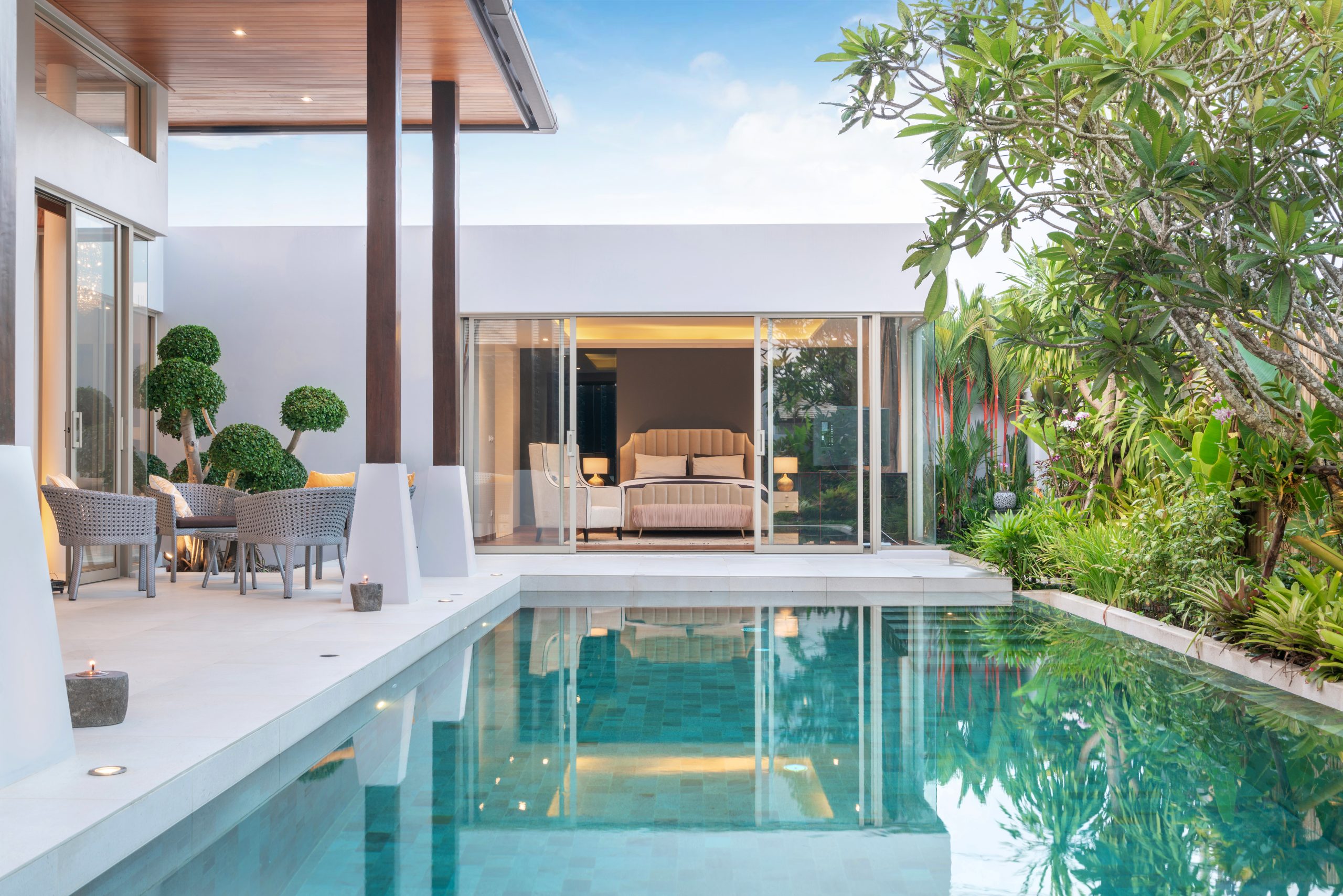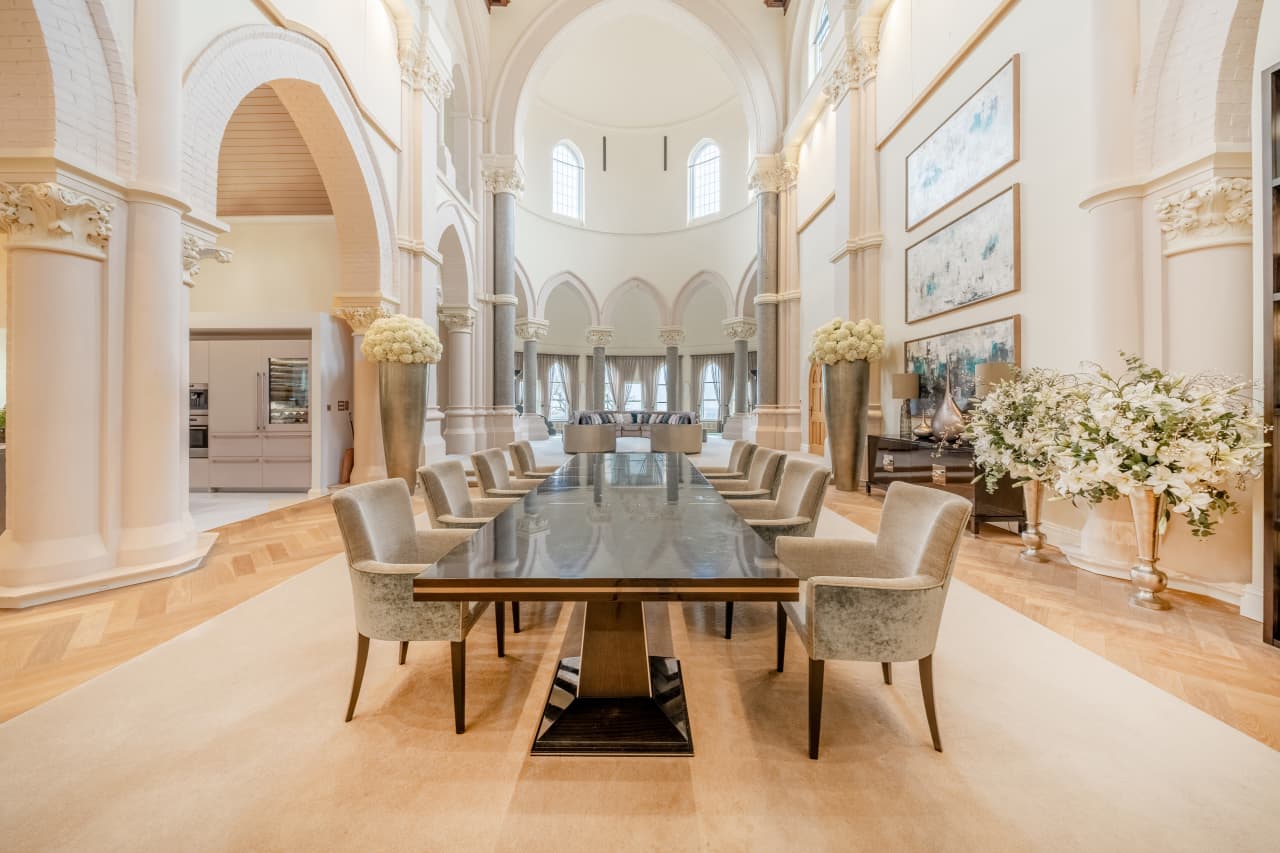A Virtual Golf Venue, A Metaverse Space: Rooms You’ll Find In Future Homes
Real-estate developers forecast the new additions that homeowners will expect.
A pandemic that left many people sequestered at home gave them a lot of time to think about spaces that would better cater to their future selves. Now developers are starting to integrate more comprehensive plans for working and learning into the rooms they design for new homes, says Andres Miyares, chief operating officer of CC Homes, a builder based in Florida. Some clients have more idiosyncratic ideas. From high-tech places for getting active to spaces devoted entirely to other dimensions, here are some of the rooms that could become must-haves in homes of the future.
An Indoor Sports Center
Rec rooms are going high-tech, says John Kean, founder of design/build company Kean Development, which designs homes in New York, Palm Beach and the Hamptons.
Indoor golf simulators that were once too expensive for most single-family homes are showing up more often now that prices have fallen, developers say. While the full immersive experience can cost as much as $100,000, entry-level simulators that use laser or infrared radar tracking to read the speed and spin of a golf ball and translate it to a virtual course projected on a screen are available for $6,000-$10,000. In most of these systems, players—typically using “soft-feel” golf balls—hit into the hanging screen that the game appears on. Nets can be attached on the sides of the setup to stop balls from flying into different areas of the room.
On some systems, game consoles can be connected to the projector to play your favourite games on a big screen. Many do double duty as entertainment systems for kids. “Every year, they’re getting better and better,” says Mr. Kean, who predicts they could replace TVs in some homes because of their wide screens.
A Space for the Metaverse
Gamers are looking for places to do their thing without stubbing a toe on their coffee tables as virtual reality gains popularity. Sales of VR headsets rose more than 70% last year from 2020, according to International Data Corp., with demand driven in part by rising hype around the metaverse, a term proponents use to describe a future 3-D version of the internet. Fine Homes By Hearthstone Corp., a California-based architectural and home construction firm, has recently started building virtual-reality rooms in people’s homes that include padded walls to protect them from hurting themselves as they don headsets and wander digital realms.
Virtual-reality gaming systems are included in many of the fully furnished homes the company sells. Customers haven’t yet inquired about the metaverse, “but I see that being something in the future,” says Robb Daniels, FHB Hearthstone’s owner. Some of the VR rooms have surround-sound speakers and vibration sensors in the floors to maximize the virtual experience. Mr. Daniels compares the technology to the vibration pads that some theatres use in seats, triggered by bass tones in movies.
“We’re just trying to make it a little bit more immersive, so they can enjoy it,” says Mr. Daniels of the custom-made rumble rooms for VR enthusiasts.
A Garage Without Grease
A shift to electric vehicles could also mean less grease and more connectivity in your garage. Some owners of EVs are already putting down flooring over the concrete in their garages and adding extra storage space. “It almost becomes an additional room to the home,” says Lisa McClelland, senior vice president of design studios at Toll Brothers Inc., a luxury-home builder.
Electric vehicles could lead more people to think of their garages as an energy source rather than just a spot to store a car. “As you start to transition to the electric vehicle, it starts to really integrate with the home,” says Nora Hennings, senior director of business development at Sunrun, a provider of home batteries that can be charged by solar panels. Last year, Sunrun announced a partnership with Ford Motor Co. on the F-150 Lightning electric truck. Those who buy the F-150 Lightning can also purchase Sunrun’s “Home Integration System” that, when paired with the charge station, enables the truck to serve as a backup power source for a home during an outage.
The Sound-Proof Room
Sound-damped studios typically associated with music production are in demand–but for new reasons. Customers need them for their internet broadcasts. “They’re using those for [making] podcasts as well,” says Dan Fuller, owner of Haley Custom Homes, a home-builder in Denver, Colo.
The pandemic’s focus on the home as a center for work and recreation has also heightened the appeal of the sound-proof room. “Everything can be done from the house,” Mr. Fuller notes.
One client commissioned a sound-proof room to use for teaching online real-estate classes, says Phil Kean, president of Phil Kean Design Group, a construction firm in Florida. “The doors had to be soundproof,” Mr. Kean says. He used fabric on the walls that absorbed sound and added extra electrical outlets for technical equipment.
The Multi-Tasking Space
One room to do the job of several: Behring Co. real-estate development company calls this the 18-hour space, a room that can be transformed for different uses.
Equipped with flex desk areas and retractable screens, the room is designed to accommodate various people and activities from day into evening. A projector setup that’s used for virtual meetings can also be used for family movie night. “That space works around the clock for them,” says Colin Behring, chief executive officer of the Bay Area company.
Though convertible rooms existed before the pandemic, the need for work-from-home and relaxation areas increased after Covid-19 emerged. Giving underutilized rooms multiple uses has become a smart alternative, Mr. Behring says. “It is a better solution that increases utility, adds value and lowers the cost for everyone all at the same time.”
 Copyright 2020, Dow Jones & Company, Inc. All Rights Reserved Worldwide. LEARN MORE
Copyright 2020, Dow Jones & Company, Inc. All Rights Reserved Worldwide. LEARN MORE
This stylish family home combines a classic palette and finishes with a flexible floorplan
Just 55 minutes from Sydney, make this your creative getaway located in the majestic Hawkesbury region.
This may be contributing to continually rising weekly rents
There has been a substantial increase in the number of Australians earning high incomes who are renting their homes instead of owning them, and this may be another element contributing to higher market demand and continually rising rents, according to new research.
The portion of households with an annual income of $140,000 per year (in 2021 dollars), went from 8 percent of the private rental market in 1996 to 24 percent in 2021, according to research by the Australian Housing and Urban Research Institute (AHURI). The AHURI study highlights that longer-term declines in the rate of home ownership in Australia are likely the cause of this trend.
The biggest challenge this creates is the flow-on effect on lower-income households because they may face stronger competition for a limited supply of rental stock, and they also have less capacity to cope with rising rents that look likely to keep going up due to the entrenched undersupply.
The 2024 ANZ CoreLogic Housing Affordability Report notes that weekly rents have been rising strongly since the pandemic and are currently re-accelerating. “Nationally, annual rent growth has lifted from a recent low of 8.1 percent year-on-year in October 2023, to 8.6 percent year-on-year in March 2024,” according to the report. “The re-acceleration was particularly evident in house rents, where annual growth bottomed out at 6.8 percent in the year to September, and rose to 8.4 percent in the year to March 2024.”
Rents are also rising in markets that have experienced recent declines. “In Hobart, rent values saw a downturn of -6 percent between March and October 2023. Since bottoming out in October, rents have now moved 5 percent higher to the end of March, and are just 1 percent off the record highs in March 2023. The Canberra rental market was the only other capital city to see a decline in rents in recent years, where rent values fell -3.8 percent between June 2022 and September 2023. Since then, Canberra rents have risen 3.5 percent, and are 1 percent from the record high.”
The Productivity Commission’s review of the National Housing and Homelessness Agreement points out that high-income earners also have more capacity to relocate to cheaper markets when rents rise, which creates more competition for lower-income households competing for homes in those same areas.
ANZ CoreLogic notes that rents in lower-cost markets have risen the most in recent years, so much so that the portion of earnings that lower-income households have to dedicate to rent has reached a record high 54.3 percent. For middle-income households, it’s 32.2 percent and for high-income households, it’s just 22.9 percent. ‘Housing stress’ has long been defined as requiring more than 30 percent of income to put a roof over your head.
While some high-income households may aspire to own their own homes, rising property values have made that a difficult and long process given the years it takes to save a deposit. ANZ CoreLogic data shows it now takes a median 10.1 years in the capital cities and 9.9 years in regional areas to save a 20 percent deposit to buy a property.
It also takes 48.3 percent of income in the cities and 47.1 percent in the regions to cover mortgage repayments at today’s home loan interest rates, which is far greater than the portion of income required to service rents at a median 30.4 percent in cities and 33.3 percent in the regions.
This stylish family home combines a classic palette and finishes with a flexible floorplan
Consumers are going to gravitate toward applications powered by the buzzy new technology, analyst Michael Wolf predicts























